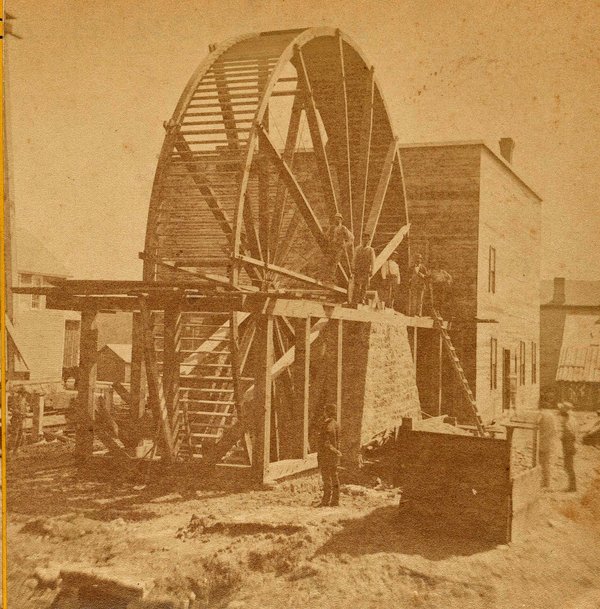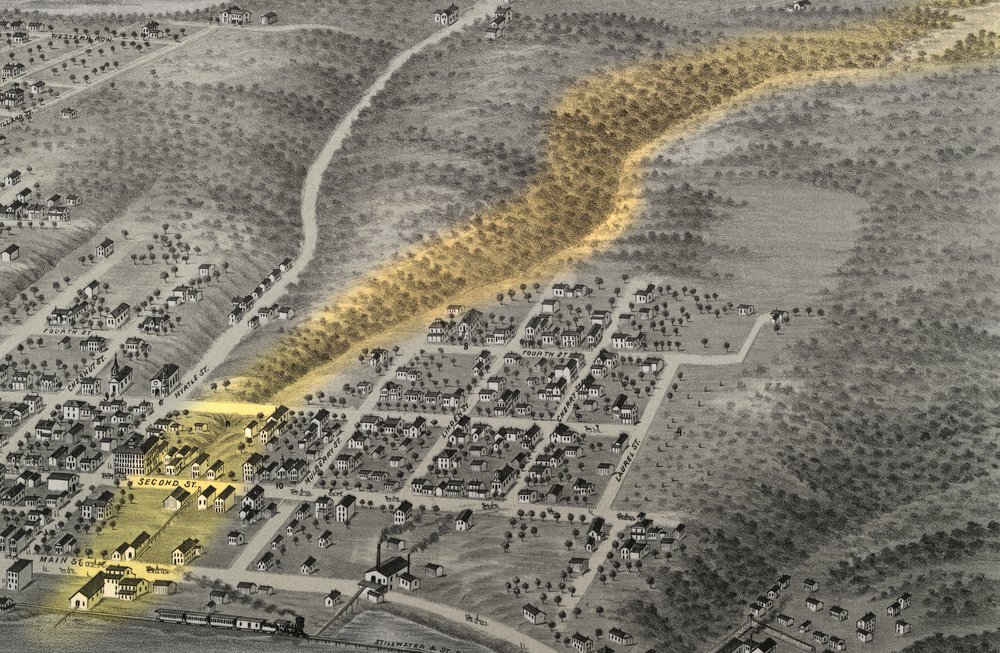Stillwater Lumber Company Mill
Stillwater had its beginnings with an idea of several men who wanted to start a lumber company. Locating at the present site of the city of Stillwater, the idea, plan and corporation were hammered out in a cold, damp log house near the St. Croix River.
Over the winter of 1842-1843 Jacob Fisher spent his time at the Tamarack House of Joseph Brown. One day, following raccoon tracks up Brown’s Creek led Fisher to a lake. Looking over the surrounding area, he felt that he could change the course of the water down the ravines and have enough power to operate a lumber mill.
Fisher staked out his claim south of the Tamarack House and over the winter discussed the possibility of a mill to Elam Greeley, Calvin Leach and Elias McKean. He also wrote to a friend, John McKusick, about the mill possibility.
The four men decided to purchase Fisher’s claim and hire him on as the millwright. McKusick and the others met in St. Louis for machinery. The machinery was shipped on the steamer St. Louis Oak to Galena, Illinois, where it was transferred to the Otter. It arrived in Stillwater on October 10, 1843. On October 26, 1843, the four men signed an incorporation agreement dividing the company into fifteen shares. The shares were spread out as follows: McKusick five shares, Greeley four shares, and McKean and Leach three shares each. It was also agreed that if one wanted to sell their shares others in the company could have first right of purchase. Thus began the Stillwater Lumber Company.
The mill was located next to the river–just north of Myrtle Street–but the mill was operated by water coming down through the ravine then carried by a flume, which then poured over the mill wheel thus operating the mill. The size of the mill was 42x80 feet, two stories high, and was located at what is now the northeast corner of Main and Myrtle Streets.
The mill consisted of two sash saws and one lath machine; the capacity was about twelve thousand feet in twenty-four hours. It was a belt geared mill and run by an over-shot wheel of thirty feet diameter.
In the November 1, 1907 Stillwater Gazette there appeared an article titled, “Aged and Venerable Manuscript,” which was the Stillwater Lumber Co. Time Book dated October 1843.
According to the article, the mill cut its first logs on March 30, 1844, and then closed for a time because of high water... an event referred in the old book as “backwater month.” The time book had the names of Jacob Fisher, James Patten, A.J. Drake, William Middleton, O.F. Strickland, C. Simonds and Hugh McFadden.
At the bottom of the July page in the book, written in bold, proud letters, “July 6 – First raft left Stillwater for St. Louis, Missouri.” This was supposedly a lumber raft with Stephen Hanks as the pilot. Hanks was a first cousin to President Abraham Lincoln.
Within a short time John McKusick had purchased his partners' shares in the mill and continued to operate it alone.
The mill operated consistently for ten years, then on and off for about five years when a gristmill was added to it. In 1847 and 1848, tax assessment records valued McKusick’s mill at $8,000.
By the 1850s, much of the mill was made for higher output of lumber, which included two upright and two circular saws each capable of sawing one million feet annually, a double lath saw capable of sawing two million lath annually and all being driven by a mill-wheel of 96 feet in diameter.
During a heavy rain in the spring of 1852, a landslide came down through the ravines of Stillwater, depositing with the surge much mud and sand around the mill. It was feared that the machinery was destroyed and that McKusicks mill was no more. Fortunately the machinery was in working order, and the sand and mud created more buildable land in what is now downtown Stillwater.
The McKusick Lumber Mill remained an important part of Stillwater’s business scene until June 1871 when it was demolished. The mill produced lumber for the old American House in St. Paul and the first mill dam at St. Anthony Falls, as well as buildings in Hudson and Hastings.
In the Stillwater Messenger of June 30, 1871, the editor gives a eulogy for the mill: “Thus, having withstood the elements, ‘lo, these many years,’ it is forced to give way to the march improvement, and be ruthlessly torn down by the hand of those who little think or care for its age or crepitude. So it is with us all. A little life and activity, and then we are hid away among the numbered millions of the dead, soon to pass from memory and be forgotten. We may well ask, with Rip Van Winkle: ‘Are we so soon forgotten when we are gone?’”
To make sure the mill was not to be forgotten, Capt. J.E. McKusick took some of the choicest white oak timber from the remains of the mill and had canes made and he presented those canes to old settlers of the area and some close friends. One of the canes still resides in the collections of the Washington County Historical Society.
The gristmill remained in operation until 1901 when fire destroyed most of the structure. The rest was torn down and made way for modern business blocks.
Currently the site of the first mill of Stillwater is a pedestrian plaza and restrooms. The resting place of the original time book is unknown.
—Brent Peterson
Brent Peterson is the Executive Director of the Washington County Historical Society.


